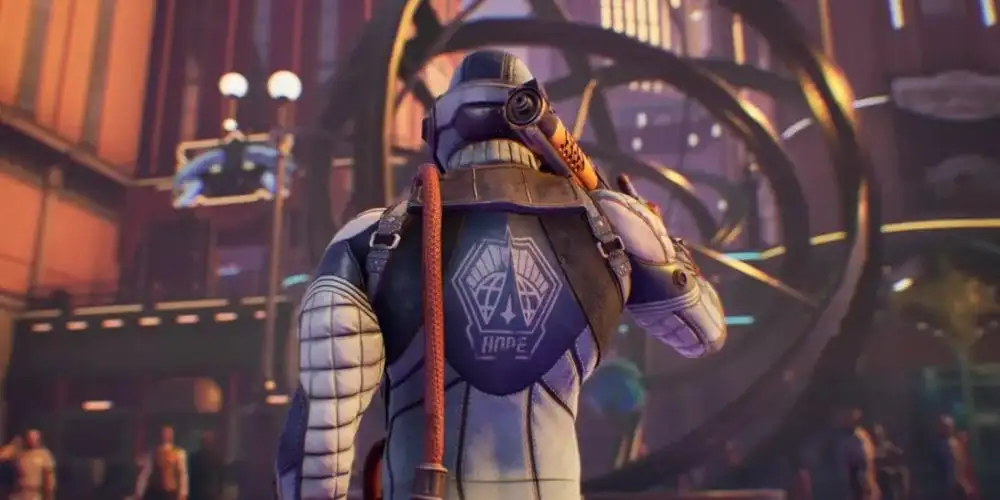Fallout New Vegas is one of my favorite RPGs of all time; it managed to capture the survival loop of the franchise so well, but had incredibly quirky writing and storytelling that made it stand out from the rest of the pack. Unfortunately, I fell off the franchise after that.
I’m not entirely sure why, but Fallout 4 and Fallout 76 just failed to capture my attention past the opening hours. Walking away from playing nearly two hours of The Outer Worlds, though, I felt like I did jumping into Fallout 3 and New Vegas, absolutely ready to see more.
Our hands-on time dropped us right into a later part of the game with a character that was level 10, exploring Monarch, one of many planets you’ll visit in The Outer Worlds. While this was clearly intentional, the save dropped me right in front of a road sign, opening up multiple opportunities on what I wanted to do.
I decided to turn around and head into the town right behind me, Fallbrook. Turns out the city was an escape for space-faring travelers, a betting haven for them to kick back and relax. There was plenty of buildings to poke around and see what I could find.
The Outer Worlds’ developer Obsidian has put a large emphasis on companions in a lot of its marketing so far, and it’s clear that they’re going to be a huge part of the game. While I was exploring Fallbrook, my two companions, Parvati and Nyoka, chimed in on different areas and even during conversations with NPCs.
Whenever I play a game like Fallout, I like to take a meticulous approach, exploring everywhere I can and talking to everyone I can. You can’t talk to every NPC in Fallbrook, but a majority of them have unique dialogue to follow through. Eventually, I wound up in a building near the back, where I stumbled upon Catherine Malin, the leader of Fallbrook.

Here I got my first big quest, with Malin contracting me to sabotage the C&P Boarst Factory, another nearby faction that produces a food called Boarst Wurst. Things got interesting here as there were three different ways I could approach this quest.
I could go in guns blazing and blast my way up to the factory’s owner, Clive, and kill him. I could sneak in and sabotage the factory, getting out before anyone even knew. Or I could get a fake employee badge and walk right in under their noses. I opted for the third option, heading to the Sundry store, where I had to use my Charm stat to convince the shop owner to give me the fake ID.
While there I took a look at the shop’s weapons, deciding to add a Plasma Cutter melee weapon to my armory. Now I was ready to head out into the wild, and it didn’t take long for me to run into a group of marauder enemies.
In addition to my Plasma Cutter, the demo gave me access to three different weapons; a long-range sniper rifle with a scope, a heavy pistol with some serious stopping power, and a massive Gatling gun-type weapon.
Combat is easily where The Outer Worlds surprised me the most, and I went in expecting a somewhat clunky shooter-RPG. However, what I played seemed like a truly fast-paced shooter with a ton of different options.

Don’t get me wrong, Outer Worlds doesn’t feel as smooth as something like Call of Duty, but it definitely feels leaps and bounds above something like Fallout 4.
Shooting feels tight and responsive, and it’s incredibly easy to switch between weapons using the Y button on the Xbox controller. Just a quick tap switches between weapons, while holding it down will open the weapon wheel.
Each weapon has great sound design, with serious weight behind each shot you fire. It reminded me of the deep weapon sounds of war games, rather than something super sci-fi.
Companions are super useful in battle, and you can command them to use powerful special attacks by pressing left or right on the D-pad, with a short cooldown afterward. These abilities lock the camera on the companion, but they’re incredibly powerful and can help you out of a pinch.
Adding onto this is a system called Tactical Time Dilation, which essentially feels like a real-time VATS. By pressing the left bumper, you’ll slow time down to a crawl, letting you aim and shoot while enemies sputter on.
Every time you level up you can add a point to a number of perks, and certain perks will let you extend the time you can use Tactical Time Dilation, and how fast it recharges. At the point I played at, the ability recharged quite fast, and as Senior Designer Brian Hines explained in our interview, it helps add a bit of a tactical layer for players that prefer RPGs over shooters.
After battling a few groups of marauders and scavenging everything I could find, I finally arrived at the Boarst factory. My fake ID worked like a charm, and we were able to just waltz right in through the front door. Once inside, though, a detection meter popped up.

Seeing as I still didn’t fully know what I was doing, I wandered around the factory until the detection meter depleted. Much to my chagrin, this meant that everyone in the factory could tell I wasn’t supposed to be there, and suddenly I was ambushed by every guard and robot in the place.
Making liberal use of my companions and the Medicinal Inhaler (mapped to RB) I was barely able to survive. A shootout like this would have probably been a nightmare to get through in Fallout New Vegas, but the improved shooting mechanics in Outer Worlds definitely made the hectic battle more enjoyable.
For good measure I also decided to sabotage the cystypig feeding area too, feeding them 4000% extra cans of food. That should be fine, right? Finally, I found Clive, the objective of the mission and after seeing his room, where he disembowels people to add into the food, I decided he might as well just die.
Making my way back again to Fallbrook, I was rewarded with a ton of XP and items for completing the quest. However, there were drawbacks. My reputation went up with the people of Fallbrook, but by killing Clive I severely injured my reputation with the C&P Boarst company.
It’s hard to say what ramifications this could have later on, but Hines did emphasize that your reputation with certain factions can change your available quests and more.
By killing Clive I was also able to bribe Catherine into giving me access to a VIP suite in Fallbrook. There I could store my items, rest, and based on what Catherine said, even murder people without anyone making a stink.
After all, you can kill every NPC in The Outer Worlds, so you might need somewhere discreet sometimes.
My expedition to the Boarst factory took up the bulk of my playtime, but I was able to do a couple of other things. I talked to my companion Nyoka and started a personal missions for her, and I traveled to the city of Stellar Bay, which was about four times the size of Fallbrook. There I could have easily taken on three or four more quests if my time hadn’t run out.

The whole point I want to drive home here is that The Outer Worlds gave me a sense of discovery that few games do. I know comparing it to Fallout 3 or New Vegas is tired at this point, but it’s simply the best way I can think to describe it. The Outer Worlds scratched an itch that I didn’t know I had.
In just this one section on Monarch I had any number of things to do, and the entire thing was backed up by some genuinely smart and funny writing. The idea of corporations running this universe is growing on me, as NPCs do things like repeat company slogans, because it’s literally part of their job description.
Two hours out of a 40-some-odd hour game isn’t enough to make a true judgment, but Obsidian definitely has a good track record. I’m already thinking about what character build I might want to go with, and what else I might be able to uncover by exploring The Outer Worlds.
I’m still a bit cautious, as I am with any massive RPG, but The Outer Worlds has shot up my list of most anticipated games for the rest of the year.














Updated: Aug 2, 2019 10:40 am